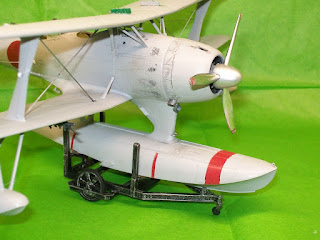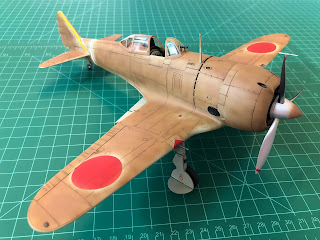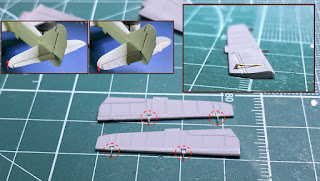
Fine Molds recent re-release of the Tamiya Messerchmitt Bf 109 E-7 kit includes two schemes for the aircraft imported and tested by the IJAAF. Aircraft '2' is depicted in its original Luftwaffe scheme and colours but aircraft '1' is depicted in an unusual if not astonishing scheme where the Luftwaffe camoufage has been applied in two brown colours. The instructions suggest two Gunze tank colours # 526 Japanese Army Brown and # 527 Japanese Army Khaki. The under surface of the aircraft and upper surface of the flaps are suggested to be Gunze 128 Gray Green. The two tank colour paints have not been analysed or measured but appear similar, if somewhat lighter, to the Gunze IJA tank set colours which have been - TC17 Brown and TC18 Khaki - shown below. The khaki appearing on the model appears lighter and more yellowish than TC18 which was observed as being reminiscent of the colour referred to as “Japanese Artillery (or Gun) Brown”, applied to ordinance including tank guns which might have been a type of service primer paint. Both the TC colours are Munsell YR - Yellow Reds and present a lower contrast than on the 109 model shown above.

TC17 Brown & TC18 Khaki

This revision of IJAAF 109 colours seems to arise from a caption in the recent Bunrindo FAOW Special Edition Vol. 8 a 'Pictorial History of Japanese Army 47th Flying-Sentai' by Yoji Watanabe. A caption to a photograph in the book (page 15) of one of the 109s taken at Fussa (Tama airfield now Yokota) suggests that the entire upper surface was a yellowish brown colour (the description used is 黄士色一茶色) applied at the German factory. That seems improbable as the yellowish brown is also attributed as the same colour applied to the Ki-44 aircraft of the Dokuritsu Hiko Dai 47 Chutai (47th Independent Flying Squadron) formed at Tachikawa with pilots from the Fussa test centre. The two airfields were closely related and adjacent to the Nakajima Musashino plant. The book includes a colour profile of a 47th Ki-44 by Shigeki Ninomiya presumably intended to represent the yellowish-brown colour, the appearance of which is approximately between Munsell 2.5 Y 4/4 and 2.5 Y 5/8. Unfortunately there is no close FS to this colour and the closest RAL 8000 Grünbraun (Green brown) is @ 6.00 (where < 2.0 = a close match) with insufficient yellowishness or ochre hue. Therefore the chip below rendered in sRGB must suffice to give an impression of the colour for those who do not have the book. The general appearance is similar to the mustard brown characteristic of Japanese Army khaki

Yellowish Brown vs RAL 8000 Grünbraun
One of the best photographs of aircraft '1' does appear to show the Luftwaffe scheme diffused or subdued and it is possible to interpret that as a thinly sprayed application of a mid-toned brown colour over the original Luftwaffe segmented camouflage such that the latter still shows through underneath, in similar fashion to the variegated or dense mottle appearance of the 47th's Ki-44s. Replicating that on a model would be labour intensive, requiring the application of a complete Luftwaffe scheme before the addition of the brown, but rather interesting to pursue.
Which Brown?
The brown colour of the 47th's Ki-44s has been variously depicted and described over the years but the degree of yellowish versus reddish undertone as represented is problematic. A colour profile in Model Art magazine # 18 of September 1969 depicts a solid and distinctly reddish brown colour similar to FS 20100 with light blue under surfaces. The profile in the 1978 Maru Mechanic book on the Ki-44 depicts a solid brown colour approximately similar to Munsell 10 YR 4/3 or FS 30145. The colour fold out painting by Ichiro Hasegawa in the Koku Fan magazine of April 1979 depicts a more reddish undertoned and variegated brown colour, the lighter tone being similar to Munsell 5 YR 4/4 or FS 20117 and the darker tone to FS 30111. In Koku Fan Illustrated # 42 of 1988 'Japanese Imperial Army & Navy Aircraft Color, Marking' the colour is described as 茶色 (cha iro - light brown or tawny, often referred to as 'tea colour') but I was unable to match the colour depicted in the colour profile to a FS colour. About the closest comparison in hue is RAL 8008 Olivbrun (Olive brown - Munsell 8.0 YR 3.6/4.8) but that is darker.
In Model Art # 329 of 1989 'Camouflage & Markings of Imperial Japanese Army Fighters' the colour is described both as 茶色 and as 土色 ( tsuchi iro - earth or soil colour). The latter does not correspond to the paint chips in the book but the paint chip designated as 茶色 is just a little lighter than Munsell 7.5 YR 4/4, between FS 30215 and 31090, and described as somewhat brown and close to a 'dry colour'. The writer asserts that the aircraft were painted grey green at the factory but that the 'earth colour' was applied after arrival in Indo-China, giving rise to the possibility that French Air Force paint was used.
Model Art # 779 of 2009, Profile # 5 on the Ki-44 settled on the description 'earth colour' and suggested that the paint was applied to match the predominant soil colour in Indo-China and Malaya. That is generally a more distinctly reddish brown than the soil colour at Tachikawa and Yokota. The printed colour chip in the book is compared to FS 30117 (Munsell 3.8 YR 4.1/3.5, a little lighter than RAL 8025 Blassbraun - pale brown) although the colour as shown and the profiles do not closely represent the FS colour being rather too purplish.
Finally the Hasegawa 1/32 scale Ki-44 kit instructions of 2012 suggest Gunze 43/H37 Wood Brown which I have not analysed or measured but which has been compared to Humbrol 9 Gloss Tan. That is Munsell 3.6 YR 4.7/7.8 and a little lighter than FS 10115. Data for the Gunze paint colour will be welcome.
Generally speaking the representations up to the time of the FAOW Special Edition and FM kit have been of a less yellowish and more reddish undertone, akin to a slightly lighter version of the IJAAF colour standard # 31 茶褐色 (chakasshoku - dark reddish brown or liver colour). The revision positions the colour closer to standard IJA Khaki, a mustard or yellowish brown colour not included in the IJAAF standard but travelling more towards parched or dried grass. Unfortunately there are no easy answers here and the subject is confused by different perceptions of what constitutes a yellowish or reddish brown, as Googling the Japanese terms in images will demonstrate. The various FS and RAL colours mentioned above can be viewed on the relevant colour charts at the following website which has verified measurement data for the colours as shown and can also be used to cross reference to other commercial colour standards:-
With special thanks to Ken Glass and Hisao Satoh for facilitating a discussion on this subject and providing insight to the FM presentation.
Image credit: Model photo and instruction excerpt © 2020 Fine Molds; Colour chips © 2020 Author















































